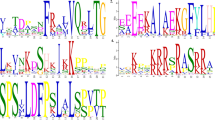Abstract
AINTEGUMENTA (ANT) and APETALA2 (AP2) are transcription factors that are involved in several developmental processes in Arabidopsis thaliana. They are similar in structure, containing two AP2 domains, and have partially redundant functions in reproductive organ development. Expression and functional analyses of ANT and AP2 homologs have been performed previously in almost all angiosperms. In this study, one ANT homolog and two AP2 homologs were isolated from the gymnosperm Pinus thunbergii and were named PtANTL1, PtAP2L1, and PtAP2L2. PtANTL1 is the first reported gymnosperm ANT homologous gene. Based on a gene tree constructed with sequences of all A. thaliana two-AP2-domain-containing genes, it is likely that PtANTL1 and ANT, and likewise PtAP2L1 and AP2, are orthologs. The expression patterns of PtANTL1/PtAP2L1/PtAP2L2 were examined with Southern hybridization of the quantitative RT-PCR products and in situ hybridization. PtANTL1 and PtAP2L1 had almost identical expression patterns in the analyzed organs, and PtANTL1/PtAP2L1/PtAP2L2 were continually expressed in the developing female cone. Our analysis suggests that gymnosperms have orthologs to both ANT and AP2, and that the most recent common ancestor of extant seed plants has two type AP2 subfamily genes, ANT-like and AP2-like, involved in the development of female reproductive organs.




Similar content being viewed by others
References
Bomblies K, Dagenais N, Weigel D (1999) Redundant enhancers mediate transcriptional repression of AGAMOUS by APETALA2. Dev Biol 216:260–264
Bowman JL, Drews GN, Meyerowitz EM (1991a) Expression of the Arabidopsis floral homeotic gene AGAMOUS is restricted to specific cell types late in flower development. Plant Cell 3:749–758
Bowman JL, Smyth DR, Meyerowitz EM (1991b) Genetic interaction among floral homeotic genes of Arabidopsis. Development 112:1–20
Chen X (2003) A microRNA as a translational repressor of APETALA2 in Arabidopsis flower development. Science Epub July 31
Chuck G, Meeley RB, Hake S (1998) The control of maize spikelet meristem fate by the APETALA2-like gene indeterminate spikelet 1. Genes Dev 12:1145–1154
Dayhoff MO (1978) Atlas of protein sequence and structure, vol 5, suppl 3. National Biomedical Research Foundation, Washington, D.C.
Drews GN, Bowman JL, Meyerowitz EM (1991) Negative regulation of the Arabidopsis homeotic gene AGAMOUS by the APETALA2 product. Cell 65:991–1002
Elliott RC, Betzner AS, Huttner E, Oakes MP, Tucker WQ, Gerentes D, Perez P, Smyth DR (1996) AINTEGUMENTA, an APETALA2-like gene of Arabidopsis with pleiotropic roles in ovule development and floral organ growth. Plant Cell 8:155–168
Jofuku KD, den Boer BG, Van Montagu M, Okamuro JK (1994) Control of Arabidopsis flower seed development by the homeotic gene APETALA2. Plant Cell 6:1211–1225
Klucher KM, Chow H, Reiser L, Fischer RL (1996) The AINTEGUMENTA gene of Arabidopsis required for ovule and female gametophyte development is related to the floral homeotic gene APETALA2. Plant Cell 8:137–153
Krizek BA (2003) AINTEGUMENTA utilizes a mode of DNA recognition distinct from that used by proteins containing a single AP2 domain. Nucleic Acids Res 31:1859–1868
Krizek BA, Prost V, Macias A (2000) AINTEGUMENTA promotes petal identity and acts as a negative regulator of AGAMOUS. Plant Cell 12:1357–1366
Kunst L, Klenz JE, Martinez-Zapater J, Haughn GW (1989) AP2 gene determines the identity of perianth organs in flowers of Arabidopsis thaliana. Plant Cell 1:1195–1208
Long J, Barton MK (2000) Initiation of axillary and floral meristems in Arabidopsis. Dev Biol 218:341–353
Maes T, Van De Steene N, Zethof J, Karimi M, D’Hauw M, Mares G, Van Montagu M, Gerats T (2001) Petunia Ap2-like genes and their role in flower and seed development. Plant Cell 13:229–244
Mizukami Y (2001) A matter of size: developmental control of organ size in plants. Curr Opin Plant Biol 4:533–539
Mizukami Y, Fischer RL (2000) Plant organ size control: AINTEGUMENTA regulates growth and cell numbers during organogenesis. Proc Natl Acad Sci USA 97:942–947
Modrusan Z, Reiser L, Feldmann KA, Fischer RL, Haughn GW (1994) Homeotic transformation of ovules into carpel-like structure in Arabidopsis. Plant Cell 6:333–349
Moose SP, Sisco PH (1996) Glossy15, an APETALA2-like gene from maize that regulates leaf epidermal cell identity. Genes Dev 10:3018–3027
Murray MG, Thompson WF (1980) Rapid isolation of high molecular weight plant DNA. Nucleic Acids Res 8:4321–4325
Nole-Wilson S, Krizek BA (2000) DNA binding properties of the Arabidopsis floral development protein AINTEGUMENTA. Nucleic Acids Res 28:4076–4082
Park W, Li J, Song R, Messing J, Chen X (2002) CARPEL FACTORY, a Dicer homolog, and HEN1, a novel protein, act in microRNA metabolism in Arabidopsis thaliana. Curr Biol 12:1484–1495
Reinhart BJ, Weinstein EG, Rhoades MW, Bartel B, Bartel DP (2002) MicroRNAs in plants. Genes Dev 16:1616–1626
Riechmann JL, Meyerowitz EM (1998) The AP2/EREBP family of plant transcription factors. Biol Chem 379(6):633–646
Saitou N, Nei M (1987) The neighbor-joining method: a new method for reconstructing phylogenetic trees. Mol Biol Evol 4:406–425
Shindo S, Ito M, Ueda K, Kato M, Hasebe M (1999) Characterization of MADS genes in gymnosperm Gnetum parvifolium and its implication for the evolution of reproductive organs in seed plants. Evol Dev 3:180–190
Vahala T, Oxelman B, von Arnold S (2001) Two APETALA2-like genes of Picea abies are differentially expressed during development. J Exp Bot 52:1111–1115
Acknowledgements
We are grateful to S. Aoki, T. Asakawa, M. Hasebe, S. Kurita, C. Mikami, and Y. Tanabe for valuable suggestions. This work was supported in part by a Grant-in-Aid for Scientific Research from the JSPS (no. 13839006 to M.I.).
Author information
Authors and Affiliations
Corresponding author
Additional information
Edited by G. Jürgens
Rights and permissions
About this article
Cite this article
Shigyo, M., Ito, M. Analysis of gymnosperm two-AP2-domain-containing genes. Dev Genes Evol 214, 105–114 (2004). https://doi.org/10.1007/s00427-004-0385-5
Received:
Accepted:
Published:
Issue Date:
DOI: https://doi.org/10.1007/s00427-004-0385-5




